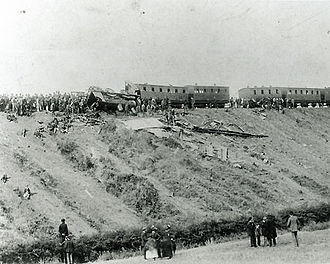Armagh Railway Accident
The Armagh railway accident on June 12, 1889 in Northern Ireland was caused by a number of technical inadequacies and was the worst railway accident that has ever occurred in Ireland .
81 dead and 260 injured were the result of this catastrophe. Since the special train was booked for a school trip, many children were among the victims.
Technical framework
Some framework conditions were decisive for the accident and its extent:
- The used for the special train locomotive was too weak for the draw weight of from 15 Cart formed coating and the manageable gradient.
- The trains on the line were equipped with Smith brakes, a vacuum brake, which became ineffective if the train separated .
- Only the first and the last car were equipped with braking devices.
- On the route , the trains did not run in space - but in time .
- The train was occupied by more than 800 people.
- The compartments, in which only children sat, had been locked by the railway staff, which was a common practice at the time.
course
On June 12, 1889, a special train for a school excursion from Armagh towards Warrenpoint stopped shortly before the end of a 4 km long slope of 1.33%. In order to be able to continue, the railway staff divided the train into two parts to first pull the first five cars to the next station . Since the Smith brake in the separated part of the train was no longer effective, the second part of the special train had to be braked by hand. But only one of the cars left behind had a handbrake. So the railroad workers put stones under the wheels of a car. The approach of the front part of the train did not initially succeed because the locomotive had come to a standstill at its dead center . To overcome this, the engine driver let the engine roll backwards a little. The 10 wagons left behind received a slight bump, which threw the stones away. They began to roll backwards and could no longer be held by the one available handbrake.
Armagh station staff hadn't heard of the special train's problems. After the prescribed period for the distance between two trains had passed, the scheduled train received a departure order. This consisted of a locomotive, a tender , a baggage car , a brake car and four passenger cars .
The runaway wagons and the locomotive of the plan train collided. The locomotive driver of the flat train saw the wagons coming towards him and braked his train so that it only drove at a speed of around 8 km / h on impact. In the collision, the three rear cars of the special train were completely destroyed. The locomotive of the scheduled passenger train overturned and the couplings between the baggage car and the remaining five cars and between the locomotive and the tender broke. The last five cars now began to roll downhill. But they could be brought to a stop by the brakes after 400 meters. Another collision threatened when the tender of the locomotive of the scheduled passenger train with the baggage car also started moving downhill and rolled towards the part of the train that had stopped. The engine driver, who had been thrown onto the tender in the collision, was also able to bring it to a standstill with the brake of the tender before hitting the stationary part of the train.
Examination result
The locomotive was far too weak to take the special train up the long ramp behind Armagh. In addition, the special train was extended again shortly before departure. The Smith brakes, as well as the running of the trains in time intervals, proved to be insufficient to compensate for the problems of the triggering malfunction.
consequences
As a consequence of the disaster, the UK Parliament passed the Regulation of Railways Act 1889 , a law that made automatic braking, space-distance travel, the train notification procedure and signal-dependent turnouts mandatory.
Similar accidents
Similar accidents in which parts of a train caused a rear-end collision with itself are:
- Railway accident at Pelm , Prussia , 1897
- Tenga railway accident , Mozambique , 2002
See also
literature
- JRL Currie: The Runaway Train - Armagh 1889 . David & Charles 1971. ISBN 0-7153-5198-2
- Ludwig Ritter von Stockert : Railway accidents. A contribution to railway operations theory. Vol. 1. Leipzig 1913, pp. 154f, No. 1.
Web links
- Assessment of the first examining officer (coroner)
- Press report on the judgment of the first investigating officer (coroner)
- Website about the accident
Individual evidence
- ^ Railway disaster ( Memento of August 10, 2009 in the Internet Archive ), National Museums Northern Ireland
Coordinates: 54 ° 21 ′ 39 " N , 6 ° 36 ′ 45" W.

